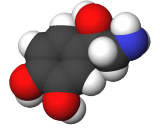Noradrenaline is the neurotransmitter of the peripheral sympathetic nervous system, responsible for so-called adrenergic neurotransmission, at nerve endings in the heart, in smooth (involuntary) muscle, and in many glands. It is one of the catecholamines. Tyrosine, an amino acid present in body fluids, is taken up into the adrenergic nerve terminal where it is acted upon by an enzyme, tyrosine hydroxylase, to form DOPA; this is converted to dopamine and in turn to noradrenaline. The neurotransmitter is stored in small vesicles, awaiting release. Arrival of the impulse at the nerve terminal releases vesicles, freeing the noradrenaline to exert its effects. To terminate the action of the transmitter, some noradrenaline is oxidized to inactive material, but most is taken back up into the nerve terminal and stored for later use. There are two types of cell membrane receptors with which noradrenaline interacts, termed a and b, each group having several subtypes.

